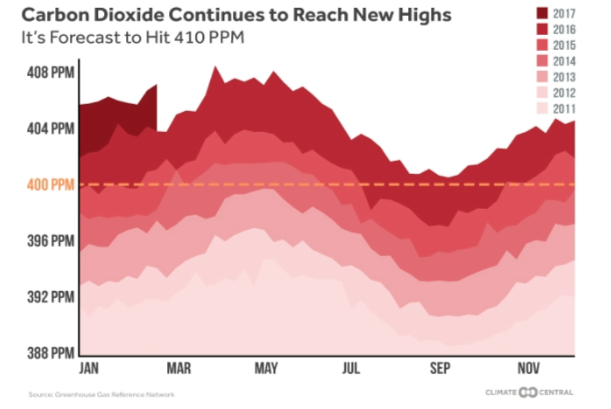Climate Central
By Brian Kahn
April 4, 2017
No, the headline is not a typo. Current carbon dioxide levels are unprecedented in human history and are on track to climb to even more ominous heights in just a few decades.
If carbon emissions continue on their current trajectory, new findings show that by mid-century, the atmosphere could reach a state unseen in 50 million years. Back then, temperatures were up to 18°F (10°C) warmer, ice was almost nowhere to be seen and oceans were dramatically higher than they are now.

The implications of the research, published on Tuesday in Nature Communications, are some of the starkest reminders yet that humanity faces a major choice to curtail carbon pollution or risk pushing the climate outside the bounds that have allowed civilization to thrive.
Atmospheric levels of carbon dioxide have varied for millennia, fluctuating largely on natural cycles. Humans have added dramatically more carbon dioxide to the atmosphere since the Industrial Revolution, though, raising carbon dioxide from 280 parts per million to nearly 410 parts per million. That has turned the thermostat up about 1.8°F (1°C) and caused a host of other impacts.
Scientists have been able to track the historic changes in carbon dioxide through a number of methods, from air pockets in Antarctic ice cores to sludge on the deep sea floor. The new research compiles 1,500 of these carbon dioxide estimates to create a view that extends 420 million years.
The carbon dioxide levels in the atmosphere today are ones that likely haven’t been reached in 3 million years. But if human activities keep committing carbon dioxide to the atmosphere at current rates, scientists will have to look a lot deeper into the past for a similar period. The closest analog to the mid-century atmosphere we’re creating would be a period roughly 50 million years ago known as the Eocene, a period when the world was completely different than the present due to extreme heat and oceans that covered a wide swath of currently dry land.
“The early Eocene was much warmer than today: global mean surface temperature was at least 10°C (18°F) warmer than today,” Dana Royer, a paleoclimate researcher at Wesleyan University who co-authored the new research, said. “There was little-to-no permanent ice. Palms and crocodiles inhabited the Canadian Arctic.”
He stressed that even if we reach those carbon dioxide levels by mid-century, crocodiles won’t suddenly appear in the Arctic. But because carbon dioxide stays in the atmosphere for centuries, climate change will continue to reshape the planet even if humans magically cut emissions to zero after hitting that peak.
————————————————————————-